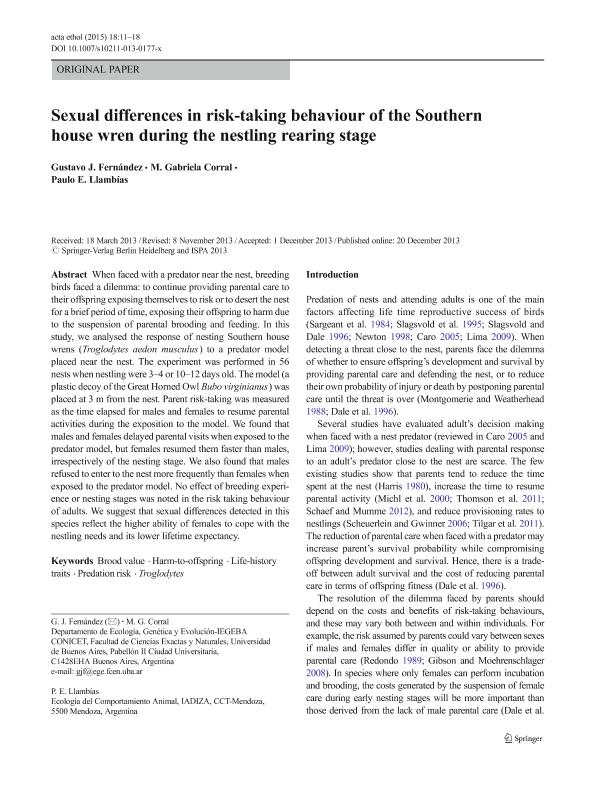Artículo
Sexual differences in risk-taking behaviour of the Southern house wren during the nestling rearing stage
Fecha de publicación:
01/2015
Editorial:
Springer Heidelberg
Revista:
Acta Ethologica
ISSN:
0873-9749
e-ISSN:
1437-9546
Idioma:
Inglés
Tipo de recurso:
Artículo publicado
Clasificación temática:
Resumen
When faced with a predator near the nest, breeding birds faced a dilemma: to continue providing parental care to their offspring exposing themselves to risk or to desert the nest for a brief period of time, exposing their offspring to harm due to the suspension of parental brooding and feeding. In this study, we analysed the response of nesting Southern house wrens (Troglodytes aedon musculus) to a predator model placed near the nest. The experiment was performed in 56 nests when nestling were 3–4 or 10–12 days old. The model (a plastic decoy of the Great Horned Owl Bubo virginianus) was placed at 3 m from the nest. Parent risk-taking was measured as the time elapsed for males and females to resume parental activities during the exposition to the model. We found that males and females delayed parental visits when exposed to the predator model, but females resumed them faster than males, irrespectively of the nesting stage. We also found that males refused to enter to the nest more frequently than females when exposed to the predator model. No effect of breeding experience or nesting stages was noted in the risk taking behaviour of adults. We suggest that sexual differences detected in this species reflect the higher ability of females to cope with the nestling needs and its lower lifetime expectancy.
Palabras clave:
Brood Value
,
Harm-To-Offspring
,
Life-History Traits
,
Predation Risk
,
Troglodytes
Archivos asociados
Licencia
Identificadores
Colecciones
Articulos(IADIZA)
Articulos de INST. ARG DE INVEST. DE LAS ZONAS ARIDAS
Articulos de INST. ARG DE INVEST. DE LAS ZONAS ARIDAS
Articulos(IEGEBA)
Articulos de INSTITUTO DE ECOLOGIA, GENETICA Y EVOLUCION DE BS. AS
Articulos de INSTITUTO DE ECOLOGIA, GENETICA Y EVOLUCION DE BS. AS
Citación
Fernandez, Gustavo Javier; Corral, María Gabriela; Llambias, Paulo; Sexual differences in risk-taking behaviour of the Southern house wren during the nestling rearing stage; Springer Heidelberg; Acta Ethologica; 18; 1; 1-2015; 11-18
Compartir
Altmétricas




